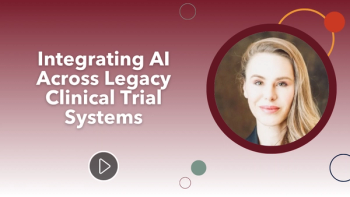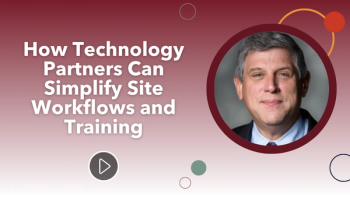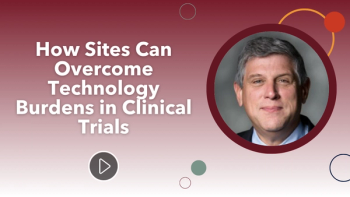
- Applied Clinical Trials-11-01-2011
- Volume 20
- Issue 11
eClinical: A Yellow Brick Road?
Examination of eClinical shows that it is more than just bold claims, there is substance.
RELATED ARTICLES
When my daughters were younger, we must have watched The Wizard of Oz together a hundred times. We never failed to be disappointed when despite all the bold words of the wizard, a look behind the curtain revealed something much less than impressive. Is the same true as we look at eClinical—bold claims, lots of talk, but little substance in reality when you drill deeper? In this article, I examine some of the success stories showing how eClinical is defining new processes and ways of working: creating a yellow brick road and not simply paving the cow path.
Industry technology trends
As is the pharmaceutical industry, the supporting technology vendor space is undergoing huge changes. The market is consolidating with vendors extending the breadth of their offerings through acquisition or organic growth. We are observing acceleration in the pace and scale of this consolidation including the large-scale acquisition that brought RTSM (randomization and trial supply management), EDC (electronic data capture), and safety offerings to be added to one corporation's CTMS (clinical trial management system) solution. In another example, an EDC provider has been building RTSM functionality within their EDC solution, while acquiring a CTMS product to broaden their suite, essentially blending internal growth and acquisition strategies. The likely outcome is a marketplace dominated by a number of large suite providers. Each provider is working to make their collection of applications into a coherent and compelling product suite, but also ensuring their framework standards enable the inclusion of other third-party systems within their environment.
Data integration: old hat
Early trends and talk around eClinical focused around how data from disparate systems could be integrated to remove duplication of data and activities. Integration of key trial technologies is now expected and often considered a "given" by the purchasers of technology systems and services. Vendors and sponsors are responding to the need to provide and support integration at volume by developing standard infrastructure and processes to enable operation at scale. Consider global shipping of goods and cargo. Standard container and hold sizes mean that goods can easily be transferred from truck to truck and from truck to ship, seamlessly and simply. A multitude of differently shaped containers would mean time lost when transferring cargo from one vehicle or vessel to another, and suboptimal use of space as containers would be unable to squeeze into all the remaining gaps and occupy the complete hold-size available. One way in which eClinical has changed the way in which we do business is that integration of key clinical trial systems have become expected rather than exceptional. As noted above, however, to achieve this growing demand, vendors and sponsors are investing in infrastructure and standards to ensure capabilities can be scaled up and applications integrated in a rapid, efficient, and supportable manner—like the cargo industry analogy. While vendors are primarily focused on the easy integration of their own applications, most are doing so by developing integration standards that will also make interaction with third-party systems simpler.
Although the industry to date has demanded the flexibility to select and combine applications from multiple suppliers, and hence required applications to publish open integration standards to facilitate this, there are movements in the industry where some sponsors are beginning to consider a complete technology suite as opposed to piecemeal applications. Specific applications, like EDC, are becoming more commoditized and purchase decisions are less based on feature comparison and more around other factors such as price and the associated product suite applications each can be supplied with. It is clear that compelling product suites that incorporate RTSM, EDC, CTMS, and SAE management—and provide plug-ins for key tactical solutions such as ePRO and medical imaging—are likely to see greater changes in purchasing behavior. Some providers are working beyond simple data integration to make their combinations of products more attractive than a collection of third-party applications. Areas of development include identity management—ensuring a common process and single sign on across a product suite, and product convergence—enabling functionality that resides in one application to be exposed through another to simplify user workflow. Both of these have huge advantages to sponsor and site users in the simplification of how they use multiple technology applications together in a single study or program. As vendors put in place their own identity management infrastructure, we see sponsors requesting federation with their own in-house identity management solutions so that in-house staff can access vendor systems directly without an additional logon.
RTSM-EDC convergence
A compelling example of product convergence is the progress some vendors are making in simplifying the workflow for site users in the way they use the core trial applications of EDC and RTSM in combination. Now used in many trials this involves the access and execution of certain RTSM functionality from within the EDC application—either through web-service integration (Figure 1) or by building the functionality into EDC. Either approach involves significant product development to enable the functionality within the EDC framework, such as building RTSM events into the EDC design tools to enable events to be selected and configured and the associated EDC data required to be identified. Additional objects and forms within the EDC application enable the events to be executed in line with the user workflow in an intuitive manner. This takes the user experience beyond the benefits of data integration.
A site user, for example, may now simply perform all patient-related tasks through a single product, their EDC application. This simplifies workflow by eliminating the need to log in and out of multiple applications to perform simple tasks, and reduces training needs as essentially all activities are completed within a single application. This popular approach may be supplemented with flexibility—enabling site users to use the telephone interface (IVR) when more convenient, as opposed to being required to use the web at all times. In this case, all data collected using IVR can be fully integrated with the EDC eCRFs. This flexibility is an advantage to certain sites that still find the phone more convenient when performing real-time activities during a patient visit. Convergence is one of the ways in which combinations of discrete applications can be made to operate in a way more valuable than the sum of their parts.
Upstream investigator portals
eClinical solutions are being used more frequently in upstream site on-boarding and qualification processes, and in managing site-sponsor collaboration during a clinical trial. Portal technologies enable a simple way to deploy site-sponsor facing functionality that can greatly enhance and simplify complex processes and are a vital component of any eClinical enabling technology platform. Simple rules engines or more complex business process management solutions can guide the site user through all the steps and activities they need to complete to become ready and approved to participate in a clinical trial. These applications typically include the ability to publish and access online site feasibility and qualification questionnaires; and the exchange and sign-off of confidentiality agreements and contracts, protocols, and other essential and regulatory documents. Providing a simple interface to navigate this activity is a major benefit for site users. Rather than receiving multiple e-mails with vast numbers of attached documents for signature or retention, the site user can be simply navigated through the sequence of activities required via the inherent rules engines. In addition, having a single place to access the most recent version of each trial document eliminates the need for individuals to keep track of multiple versions.
Some site-sponsor portals include shared collaboration spaces to enable a subset of the trial community to work together for the creation of a new document, such as a protocol amendment. Some include discussion forums, news areas, and online training capabilities. Others help to collate information to maintain and provide an electronic trial master file. Good examples presented at conferences in recent years include Novo Nordisk's investigator portal that provides an online community for investigators involved in their hemophilia trials.
eClinical-enabled paradigms
These advancements in the way technologies can be integrated and seamlessly presented together have provided the opportunity to leverage them in different and exciting ways. Pfizer announced in June 2011 that they were conducting a pilot study that would assess a completely new paradigm in the way trials are conducted—enabled because of the maturity and advancement of eClinical technologies.1 Their REMOTE (Research on Electronic Monitoring of OAB Treatment Experience) trial uses technology to allow overactive bladder patients to participate in a study of Detrol LA (tolterodine tartrate) without a requirement to visit a clinical site. This novel approach of a direct-to-patient study opens recruitment opportunities to a much wider population of patients as there is no requirement to reside geographically close to a defined study site. A patient-centred overview of this study can be viewed in a short YouTube video.2 This video explains how patients will be qualified and consented by a combination of online multimedia screening with telephone consultation by medical experts at a central study site. Participating subjects receive laboratory kits through the mail which they can take to a local clinic for tests to be undertaken. Eligible subjects receive a handheld ePRO diary by mail to record and transmit micturition data, and medication is shipped direct to their home from the single central investigational site. This approach would not be possible without the maturity of the supporting technologies and the eClinical infrastructure to integrate them seamlessly for patient, central investigator, and sponsor users.
Software as a service
The final eClinical trend worthy of note is software as a service (SaaS). SaaS promises to revolutionize how software is provided within our industry as it has successfully already within other industries. SaaS enables sponsors to leverage technologies without large capital expenditure or infrastructure investment. Hosted by a third-party, SaaS solutions often leverage multi-tenancy properties of the software applications to enable infrastructure costs to be shared effectively across customers and hence reduce the cost of hosting by sharing the expense across multiple clients. Pricing models often follow a per-usage approach, which eliminates the large capital expenditures that are commonplace when purchasing software solutions for on-premise installation.
These approaches are attractive to smaller and mid-sized pharmaceutical companies who seek to leverage technologies without the need for infrastructure and software investment, but are also showing appeal for the larger pharmaceutical companies who are looking to the cloud to reduce internal costs. Many technology vendors are seeing SaaS as a vital industry trend and we expect to see the development of increasingly greater SaaS capabilities serving our market over the coming short-term horizon.
eClinical-enabled clinical trial processes truly are becoming a way in which our industry is now doing business to leverage the true values of technologies and achieve greater productivity and efficiency gains in development. There is genuine excitement about what new developments we will see in the coming months and years that will continue to push the boundaries, create compelling product suites, make sustainable and scalable integrations, further simplify workflow through product convergence and new applications, and make technology more accessible through SaaS programs. As the Wizard of Oz himself said, "[we] should consider ourselves lucky [to be granted] an audience tomorrow instead of 20 years from now." In fact, as this article has demonstrated, we can see the impact of eClinical today—on our processes, how we use technology, and what we expect from it.
Bill Bryom is Senior Director of Product Strategy, Perceptive Informatics, Lady Bay House, Meadow Grove, Nottingham UK, e-mail:
References
1. Jennifer Corbett Dooren, "A Clinical Drug Trial Via Phone, Computer," The Wall Street Journal (June 7, 2011),
2.
Articles in this issue
almost 14 years ago
Clinical Trial Recruitment in Dermatologyalmost 14 years ago
Predicting Successful Site Performancealmost 14 years ago
Business and News Update November 2011almost 14 years ago
Seamless eClinical Solution from Perceptivealmost 14 years ago
Ethics of Biobank Research Come Under Scrutinyalmost 14 years ago
An Update to Real Innovationalmost 14 years ago
BRIC Countries Contribute to Researchalmost 14 years ago
Clinical Grant Expenditures are Stabilizingalmost 14 years ago
Patients, Investigators Seek Flexibility at FDANewsletter
Stay current in clinical research with Applied Clinical Trials, providing expert insights, regulatory updates, and practical strategies for successful clinical trial design and execution.






.png)



.png)



.png)
.png)
